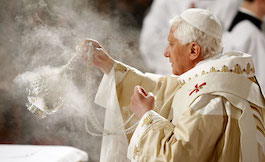Why Do Priests Use Incense?
- FR. WILLIAM SAUNDERS
Incense is an aromatic substance which is the resin from certain trees.
 When burned over charcoal, the incense produces a sweet smelling aroma. To make the smoke thicker and to enhance the fragrance, sometimes other perfumes are blended with the incense.
When burned over charcoal, the incense produces a sweet smelling aroma. To make the smoke thicker and to enhance the fragrance, sometimes other perfumes are blended with the incense.
The use of incense in the ancient world was common, especially in religious rites where it was used to keep demons away. Herodotus, the Greek historian, recorded that it was popular among the Assyrians, Babylonians and Egyptians. In Judaism, incense was included in the thanksgiving offerings of oil, grain, fruits and wine (cf. Nm 7:13-17). The Lord instructed Moses to build a golden altar for the burning of incense (cf. Ex 30:1-10), which was placed in front of the veil to the entrance of the meeting tent where the ark of the covenant was kept.
We do not know exactly when the use of incense was introduced into our Mass or other liturgical rites. At the time of the early Church, the Jews continued to use incense in their own Temple rituals, so it would be safe to conclude that the Christians would have adapted its usage for their own rituals.
In the liturgies of Sts. James and Mark, which in their present form originate in the fifth century, the use of incense is mentioned. A Roman ritual of the seventh century marks its usage in the procession of a bishop to the altar and on Good Friday. Moreover, in the Mass, an incensation at the Gospel appears very early; at the offertory, in the 11th century; and at the Introit, in the 12th century. Incense was also used at the Benedictus and Magnificat during Lauds and Vespers about the 13th century, and for the exposition and benediction of the Blessed Sacrament about the 14th century. Gradually, its usage was extended to the incensing of the celebrant and assisting clergy.
The purpose of incensing and the symbolic value of the smoke is that of purification and sanctification. For example, in the Eastern Rites at the beginning of Mass, the altar and sanctuary area were incensed while Psalm 50, the "Miserere," was chanted invoking the mercy of God. The smoke symbolizes the prayers of the faithful drifting up to heaven: the Psalmist prays, "Let my prayer come like incense before you; the lifting up of my hands, like the evening sacrifice" (Psalm 141). Incense also creates the ambiance of heaven: The Book of Revelation describes the heavenly worship as follows: "Another angel came in holding a censer of gold. He took his place at the altar of incense and was given large amounts of incense to deposit on the altar of gold in front of the throne, together with the prayers of all Gods holy ones. From the angels hand, the smoke of the incense went up before God, and with it the prayers of Gods people."
In the General Instruction of the Roman Missal incense may be used during the entrance procession; at the beginning of Mass, to incense the altar; at the procession and proclamation of the Gospel; at the offertory, to incense the offerings, altar, priest and people: and at the elevation of the Sacred Host and chalice of Precious Blood after the consecration. The priest may also incense the Crucifix and the Paschal Candle. During funeral Masses, the priest at the final commendation may incense the coffin, both as a sign of honor to the body of the deceased which became the temple of the Holy Spirit at Baptism and as a sign of the faithfuls prayers for the deceased rising to God.
The usage of incense adds a sense of solemnity and mystery to the Mass. The visual imagery of the smoke and the smell remind us of the transcendence of the Mass which links heaven with earth, and allows us to enter into the presence of God.
 This is Meaghen Gonzalez, Editor of CERC. I hope you appreciated this piece. We curate these articles especially for believers like you.
This is Meaghen Gonzalez, Editor of CERC. I hope you appreciated this piece. We curate these articles especially for believers like you.
Please show your appreciation by making a $3 donation. CERC is entirely reader supported.

Acknowledgement
 Saunders, Rev. William. "Why Do Priests Use Incence." Arlington Catholic Herald.
Saunders, Rev. William. "Why Do Priests Use Incence." Arlington Catholic Herald.
This article is reprinted with permission from Arlington Catholic Herald.
The Author

 Father William Saunders is pastor of Our Lady of Hope parish in Potomac Falls, Virginia. He is dean of the Notre Dame Graduate School of Christendom College. The above article is a "Straight Answers" column he wrote for the Arlington Catholic Herald. Father Saunders is the author of Straight Answers, a book based on 100 of his columns, and Straight Answers II.
Father William Saunders is pastor of Our Lady of Hope parish in Potomac Falls, Virginia. He is dean of the Notre Dame Graduate School of Christendom College. The above article is a "Straight Answers" column he wrote for the Arlington Catholic Herald. Father Saunders is the author of Straight Answers, a book based on 100 of his columns, and Straight Answers II.




